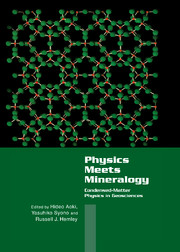Book contents
- Frontmatter
- Contents
- Preface
- List of Contributors
- Part I Introduction
- Chapter 1.1 Physics and Mineralogy: The Current Confluence
- Part II Advances in Theoretical and Experimental Techniques
- Part III New Findings in Oxides and Silicates
- Part IV Transformations in Silica
- Part V Novel Structures and Materials
- Part VI Melts and Crystal–Melt Interactions
- Subject Index
- Materials Formula Index
- Index of Contributors
Chapter 1.1 - Physics and Mineralogy: The Current Confluence
Published online by Cambridge University Press: 05 November 2011
- Frontmatter
- Contents
- Preface
- List of Contributors
- Part I Introduction
- Chapter 1.1 Physics and Mineralogy: The Current Confluence
- Part II Advances in Theoretical and Experimental Techniques
- Part III New Findings in Oxides and Silicates
- Part IV Transformations in Silica
- Part V Novel Structures and Materials
- Part VI Melts and Crystal–Melt Interactions
- Subject Index
- Materials Formula Index
- Index of Contributors
Summary
The interplay among geosciences, mineralogy, and condensed-matter physics is briefly overviewed in the context of the chapters contained in this volume. The chapters report current developments along many lines of inquiry introduced by one of the leading figures, Yoshito Matsui, for which we start with a brief history. The diverse body of work summarized in the book includes ranges from recent advances in theoretical condensed-matter physics, crystallography and crystal chemistry, high-pressure transformations, and the behaviour of high-temperature melts.
Introduction
It has long been recognized that atomic interactions are key in understanding large-scale geological phenomena, which is an approach dating at least as far back as the days of Goldschmidt [1]. Conversely, a study of the materials that comprise the planets can tell us much about fundamental physics and chemistry. This line of approach is subsequently exemplified by Pauling's development of the theory of chemical bonding from the structural studies of minerals [2].
Among many facets that revolutionized modern earth science are plate tectonic theory, discoveries in planetary astronomy, and extraordinary technical advances that provide windows on our planet's deep interior. Modern condensed-matter physics, on the other hand, has acquired much impetus from the discovery of new phenomena, the development of new experimental methods, and vast improvements in computational methods. Although physics and mineralogy have continued largely on distinct and disparate trajectories, many recent advances in both earth science and physics stem from science done at the crossroads of the two fields.
- Type
- Chapter
- Information
- Physics Meets MineralogyCondensed Matter Physics in the Geosciences, pp. 3 - 18Publisher: Cambridge University PressPrint publication year: 2000



